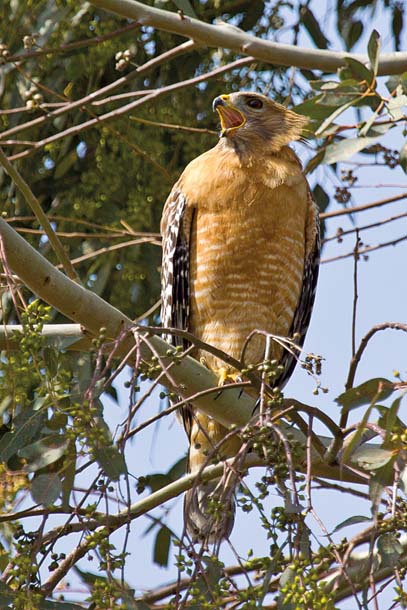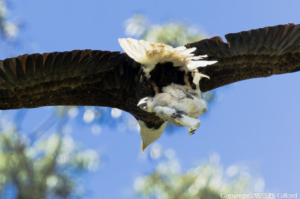Bird nesting, anybody will tell you, is a spring and summer event. And it makes sense that many birds nest when grass grows, branches bud, and bugs emerge. But to mangle a notorious quote, the noisiest nesting season I ever heard was December in the San Francisco Bay Area. And the noisiest creatures in my creekside San Anselmo neighborhood that December were not the songbirds but rather red-shouldered hawks.
Red-shouldered hawks are medium-sized raptors of California’s riparian and urban forests. Adult redshoulders (both male and female) boast black-and-white wings and tail and a handsome rust-colored breast that melds into fine rust and whitish horizontal lines lower on the body. The juvenile redshoulder plumage is a softer version of its parents’ colors with no rust in the breast. One field mark sets the California redshoulders apart from all other raptors: a distinct white crescent near the tip of each wing.
Morphology and genetics put them in the genus Buteo with red-tailed, ferruginous, and Swainson’s hawks. However, a redshoulder’s habits and habitats are accipiter-like. For instance, a redshoulder flaps in series, then glides on set wings much like a Cooper’s hawk. It will often perch hunt, “not circle over open country as Redtails do,” to quote Ralph Hoffmann, author of the 1927 field guide Birds of the Pacific States.
Regarding the redshoulder song, Hoffmann called it “high and piercing.” William Leon Dawson described it as “a ringing series that sets the woods agog, kee-a!, kee-a!, kee-a!” Early naturalists called the redshoulder “the Singing Hawk,” more in reference to the species’ incessant noisiness than to the sweetness of its sound. In their wonderfully descriptive book, Raptors of California, Hans and Pam Peeters put it bluntly: The red-shouldered hawk is perhaps “California’s noisiest raptor, often drawing attention to itself with its loud and repeated clarion calls.”

A Rise in Redshoulders
It appears that redshoulders in abundance is a fairly recent phenomenon in the Bay Area, either because the hawks were more tight-lipped in historical times or they just weren’t common here. Regarding the first hypothesis, Dawson, in The Birds of California, notes that a particular nesting redshoulder “marks our distant approach and is ill-at-ease, fearing the gun.” It should be no surprise that any diurnal raptor pre-1960s was a chickenhawk first and a unique species second. My own dear Woodside grandmother had a stuffed Cooper’s hawk on the mantel, the result of her swift trigger and eagle eye.
Are red-shouldered hawks more common in the Bay Area now than half a century ago? In the Marin County Breeding Bird Atlas, David Shuford notes that the species was rare by mid-century in California, due to the pressures of human growth and expansion, but by the early 1990s they were starting to reoccupy “the Los Angeles basin where mature trees provided nesting habitat in certain residential areas, parks, and cemeteries.” Not long after, that exact phrase could have been applied to the Bay Area as well. In 1994 and 1995, biologist Steve Rottenborn focused on the nesting redshoulders of the Santa Clara Valley and discovered that 52 of 85 nests were in nonnative trees, particularly eucalyptus. And these nonnative nest trees launched, on average, a greater number of fledgling redshoulders than did their native counterparts.
A review of Christmas Bird Count (CBC) statistics, collected and compiled under the auspices of the National Audubon Society since 1960, backs up these more anecdotal observations. For eight different Bay Area CBC circles, annual redshoulder counts increased starting in the 1960s or ’70s and peaked only in recent years. Three counts (Mount Diablo, Palo Alto, Santa Rosa) actually show populations still rising as of 2010.
This pattern holds as well for the red-shouldered hawk fall migration counts by the Golden Gate Raptor Observatory (GGRO) in the Marin Headlands. Although California redshoulders aren’t classically migratory — that is, all moving from north to south in autumn — they do disperse quite a bit, traveling dozens of miles in any direction in search of pockets of abundant prey. Twenty-five years of GGRO autumn red-shouldered hawk counts, expressed as five-year averages (to soften annual swings due to weather, etc.), show an upward trend.

Within this overall upward trend — now leveling out some — there are dramatic dips and rises from year to year. The reasons for such year-to-year variations are probably not possible to ferret out. While the count of 248 sightings from 2011 is well below the average, it’s too early to say if it’s a dip or the beginning of a decline. In either case, the apparent leveling trend may indicate that redshoulders have reached capacity in the Bay Area. This hypothesis is supported by the Christmas Bird Counts, five of which hit a clear redshoulder peak in the years 2002–2008. Have redshoulders saturated their nesting opportunities? Or are they encountering some urban challenge such as tree removals or the overuse of rat poisons? The jury is still out.
The Singing Hawk Revisited
While the jury deliberates, let’s return to our earlier question: Why should Bay Area redshoulders be so noisy in mid-winter? In these pre-breeding months, the obvious reasons would be to advertise an already-occupied nesting territory (“It’s my yard!”), or to court a potential mate (“Want to see my etchings?”), or perhaps both. Competition for urban and suburban creekside nest trees with prey nearby can be fierce. Although some of that competition may come from other redshoulders, a bigger problem (in every sense) may be great horned owls. This stems from the fact that the owls don’t build their own nests; they re-use the nests of others, preferably old hawk nests, such as the sturdy, thatched stick-bowls created by red-tailed or red-shouldered hawks during an earlier nesting season. Many of these hawk nests are in tall, open-canopy trees like eucalyptus, sycamore, cypress, and cottonwood, where large-winged raptors can fly through the canopy with little interference.
In the mid-2000s, biologist Kim Meyer conducted a two-year census of nesting raptors in the Presidio of San Francisco for the National Park Service, which had recently inherited the former military base. Meyer located 45 nesting pairs, a mix of Cooper’s, red-tailed, and red-shouldered hawks, and great horned owls. In both years combined, he counted 20 redshoulder nests, all of which were in nonnative trees, mostly eucalyptus.
Although the density of raptor territories was impressive (ten nests for every square mile in 2006!), what really got my attention from Meyer’s research on the Presidio raptor community was the early fledging dates for great horned owls and red-shouldered hawks. The earliest redshoulder fledging took place on May 28. Working back through the known numbers of days for brooding, incubation, and laying, that pair of redshoulders had to be nest building by February 1 and in full-on courtship for weeks before that, maybe even before the New Year. Similar calculations for the owls put them on eggs in early January, meaning courtship in December or even earlier.
For me, this is headline news: Bay Area raptors can start nesting in December. And for a nonmigratory homebody like the red-shouldered hawk, this makes sense. Because redshoulders take a huge range of prey, from crawdads to sticklebacks, from newts to shrews, and from pocket gophers to rock pigeons, they can find food here in the Bay Area any time of year and, ergo, stay put in a relatively small patch of forest from one nesting season to the next.
This red-shouldered-hawk system of land tenure works fine until December when a great horned owl or two, also omnivorous and determined to power-grab last year’s hawk nest, show up, hooting like crazy. What’s a redshoulder to do? Be noisy back. Sing. Sing for territory defense. Sing to secure a mate and better defend the territory. And so, come December, when you hear that insistent kee-a! at its roughly one-per-second interval, “setting the woods agog,” remember it’s not easy being a red-shouldered hawk in the urban Bay Area forests.





